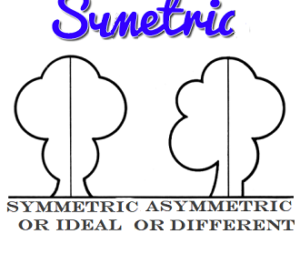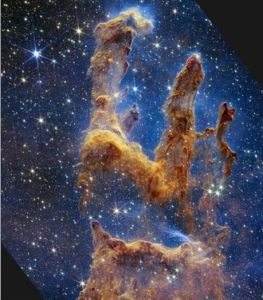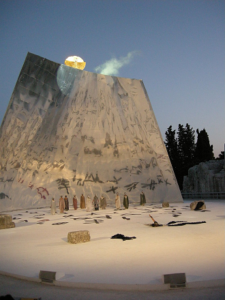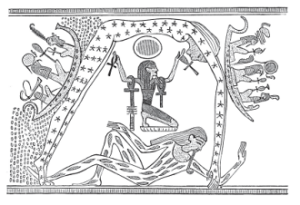
Arquivo para a ‘Linguagens’ Categoria
Power, punishment and psychopolitics
After Surveillance and Punishment, Foucault realized that disciplinary society was not exactly what modern society reflected, as Byung-Chul Han’s book on Psychopolitics puts it, “the problem, however, was that it remained linked both to the concept of population and to that of biopolitics [quoting Foucault] ‘if once we know what this governmental regime called liberalism was, we can, it seems to me, grasp what biopolitics is’ (Han, 2020, p. 37).
realized that disciplinary society was not exactly what modern society reflected, as Byung-Chul Han’s book on Psychopolitics puts it, “the problem, however, was that it remained linked both to the concept of population and to that of biopolitics [quoting Foucault] ‘if once we know what this governmental regime called liberalism was, we can, it seems to me, grasp what biopolitics is’ (Han, 2020, p. 37).
Byung-Chul discovers that “disciplinary technique passes from the corporeal to the mental sphere. The English term “industry” also means “effort”. The locution industrial school can mean house of correction. Bentham also suggested that his pan-opticon would morally improve the inmates. Content, the psyche is not the focus of disciplinary power” (Han, 2020, p. 35).
The Korean-German essayist develops all the assumptions developed by Foucault to make the transition from biopolitics to psychopolitics, which he is right to do, but it is totally linked to the idea that it is the neoliberal principle and not the Hegelian one that establishes this logic of power, although both in the book What is Power and in the book In the Swarm, he examines other aspects ranging from technology to human behavior, for example, in the essay In the Swarm, he states that the only symmetrical form of power is respect.
In a more analytical way, he also considers idealist philosophy from a behavioral perspective:
“As in the relationship of knowledge (Kant), there is no continuity of the Ego, without the Alter, as he attests, by denoting that, power allows the ego to be in the other by itself. It generates a continuity of the self. The ego makes its decisions in the alter. This is how the ego continues in the alter. Power gives the ego spaces that are its own, in which, despite the presence of the other, it can be itself.” (Han, 2019, p. 11).
So it is necessary to escape from selfish, exclusivist concepts to penetrate a level of alter in order to fully realize our feelings and decisions, it is not an effort of the self nor of egocentric power that we achieve this state of peace and happiness so desired.
So inflamed egos, masters who seize power in order to dominate others, are unable to create a healthy policy that includes the whole of society and perhaps the whole of society, because it is not possible to live in harmony without respecting diversity, difference and the Other.
All totalitarian regimes are heading for war because they need to eliminate the Other, the different and the voice of those who see the world from a different perspective.
HAN, Byung-Chul. A Psicopolítica: o neoliberalismo e as novas técnicas do poder. Brazil: Petrópolis: Vozes, 2020.
HAN, Byung-Chul. O que é Poder? Transl. de Gabriel Salvi Philipson. Brazil: Petrópolis: Vozes, 2019.
Maximum tension between NATO and Russia
Accusations of direct aggression between the West and Russia have reached a dangerous limit.
The tensions surrounding the war in Eastern Europe have reached an all-time high. British Prime Minister Keir Starmer and US President Joe Biden are reportedly talking about allowing Kiev to use American ATACMS and British Storm Shadow long-range missiles on internal Russian targets.
On the other hand, China and Russia have held joint military exercises called “Joint SEa-2024”, which Japan and Eastern countries view with suspicion, as well as Taiwan and the islands that are conflicts between Japan and Russia (Sakhalin and Kuril Islands) and China and the Philippines (Spratlye Islands and Scarborough Atoll), but the main conflict is markets with the West.
Russia has used drones from Iran in the confrontation with Ukraine, and this strengthens the link with the Muslim world, while support for Israel from France and the US strengthens the NATO alliance.
Brazil and China had proposed a peace proposal that would “freeze the current borders” in a ceasefire, but this referred to May, now the advance of the Ukrainians into Russian territory changes this scenario, and it is not clear what the proposal actually is, but Ukrainian President Zelensky had already rejected the proposal, saying he was not consulted.
The scenario is serious because a simple attack on Russian territory with long-range missiles will be considered a NATO aggression, since Western countries have offered weapons and given a go-ahead, while NATO forces are preparing a possible retaliation.
On the Middle East front, as I explained with almost the same allies and enemies, the climate is also one of hostility and an agreement seems to be further and further away.
A senior Hamas commander, Oussama Hamdane, in an interview with AFP accused the United States of not exerting enough pressure on Israel to seek a ceasefire agreement, and claims that on the contrary “it is trying to justify the Israeli side’s evasion of any compromise”, and American political strength would be able to lead the Middle East to a hope of peace in a conflict that has gone beyond humanitarian limits.
There are still hopes, voices calling for serenity and common sense, various organizations and entities that are honestly seeking a reasonable and lasting peace.
Joy, sacrifice and hope
Pain is part of human reality, and so no joy is everlasting if it doesn’t understand sacrifice, in the etymology of the word “sacred office”, it’s not exactly pain, as Byung-Chul Han describes in The Palliative Society: pain today, meaningless pain, it’s “bodily affliction”, pain has become a thing, it has lost an ontological and in a way “eschatological” meaning, “meaningless pain is possible only in a bare life emptied of meaning, which no longer narrates”. (Han, 2021, p. 46).
everlasting if it doesn’t understand sacrifice, in the etymology of the word “sacred office”, it’s not exactly pain, as Byung-Chul Han describes in The Palliative Society: pain today, meaningless pain, it’s “bodily affliction”, pain has become a thing, it has lost an ontological and in a way “eschatological” meaning, “meaningless pain is possible only in a bare life emptied of meaning, which no longer narrates”. (Han, 2021, p. 46).
Han cites literary authors such as Paul Valéry, for whom in his book Monsieur Teste “is silent in the face of pain. Pain robs him of speech” (Han, 2021, p. 43), and also Freud, for whom ”pain is a symptom that indicates a blockage in a person’s history. The patient, because of his blockage, is unable to move forward in the story” (p. 45).
It is with the Christian mystic Teresa of Avila, as a kind of counterfigure of pain, “in her, pain is extremely eloquent. The narrative begins with pain. The Christian narrative verbalizes pain and also transforms the body of the mystic into a stage … deepens the relationship with God … produces intimacy, an intensity” (p. 44). For those who don’t know, it was through reading this book that the philosopher Edith Stein, a disciple of Husserl like Heidegger, converted to Christianity.
Sacrifice is the art of living joyfully through pain. Of course, it’s a mistake to think about and desire pain, but if it comes, and someday it will, it can be re-signified as a “sacred office” that is offered. Byung-Chul Han wrote about it: “Suffering is not a symptom, nor is it a diagnosis, but a very complex human experience.” Only great mystics have penetrated it.
In Mark’s Gospel (Mk 9:31), Jesus shocks his disciples by teaching them in secret: “And he said to them, ”The Son of Man is going to be delivered into the hands of men, and they will kill him. But three days after his death he will rise again,” and then he denies all forms of human power: ‘Whoever wants to be first, let him be servant of all,’ and finally he teaches the simplicity of children: ‘Whoever welcomes one of these children welcomes me,’ is different from what they think today.
Understanding pain, the inverted logic of power and the simplicity and innocence of children is a distant logic in a civilization in crisis, hedonistic, authoritarian and full of malice.
Han, B-C. (2021) A Sociedade paliativa: a dor hoje. Transl. Lucas Machado, Brazil, Petrópolis: ed. Vozes.
Asymmetries, power and sociability
The Korean-German essayist Byung-Chul Han, in his book In the Swarm, points out that only respect is symmetrical, the various forms of communication and power are asymmetrical, but this taken to the limit causes hatred, contempt and war.
in his book In the Swarm, points out that only respect is symmetrical, the various forms of communication and power are asymmetrical, but this taken to the limit causes hatred, contempt and war.
Jacques Rancière, who wrote “Hatred of democracy”, points out that this theme has taken on dramatic contours today, but already exists in literature: “The author points out that rejection of democracy is nothing new, but it has new contours:
Its spokespeople inhabit all the countries that declare themselves not only democratic states, but democracy tout court. None of them claim a more real democracy. On the contrary, they all say that it is already too real. None complain about the institutions that claim to embody the power of the people, nor do they propose measures to restrict that power.
Rereading the literature, he recalls authors who defended it: “The mechanics of the institutions that enchanted the contemporaries of Montesquieu, Madison and Tocqueville do not interest them. They complained about the people and their customs, not the institutions of their power. For them, democracy is not a corrupted form of government, but a crisis of civilization that affects society and the state through it,” and so we don’t speak of a ‘crisis of civilization’ at random.
The discussion of the media influencing politics has been around for centuries, as has the fact that defaming opponents through situations that are not always true or even out of context is a common practice to try to impose an opinion in an asymmetrical way.
The fact is that we now have a more powerful medium that can potentiate these falsehoods and the new media are not just control algorithms or efficient Artificial Intelligence mechanisms, now a new technological approach, the fact is that we have to seek a balance, a symmetry from personal relationships to power.
You can’t apply laws unilaterally, or even make them to suit political situations, they must apply to everyone and if they change they must follow a rite and the appropriate institutions for this, trampling on powers, anticipating processes or making summary rites are abuses of power.
This is how we start with respect for opinion, for dialogue, for what is different, and arrive at the exercise of power with moderation and the utmost fairness, even if opposing forces confront the contradictory discourse, this must be done within the framework of legality and legitimacy.
On a personal level, overcoming stalemates, raids and personal differences with parsimony and respect helps to balance social relations, even if it often borders on offense on one side.
It’s not a heroic attitude, it’s a defense of coexistence, tolerance and social peace.
Rancieré, J. (2007). Hatred of Democracy. USA, NY: ed. Verso.
Joy in the midst of crisis
It´s possible to maintain joy in the midst of crisis, economic difficulties and wars that threaten us? This is not about naivety or mere alienation, others prefer to think about maintaining their essential assets: food, health and safe housing.
economic difficulties and wars that threaten us? This is not about naivety or mere alienation, others prefer to think about maintaining their essential assets: food, health and safe housing.
Byung-Chul theorizes that despite the “difference” between Derridá and Heidegger (see our posts about Heidegger´s heart book) there is a structural affinity in their vision of mourning, which is characterized by the renunciation of the subject’s autonomy in Derrida: “No matter how narcissistic our subjective speculation continues to be, , it can no longer close itself to this gaze, before which we ourselves show ourselves the moment we convert it into our mourning or we can give up on it [faire de lui notre dueil], mourning, making ourselves mourn for ourselves, I mean, I mourn the loss of our autonomy, for everything that made us the measure of ourselves” (Han, p. 430 citing Derridá’s text “Krafter der Trauer”, strengthening of pain), this That is, they both have in common a vision of renouncing the autonomy of the subject, the “I” of idealism.
Here the important thing is not to let mourning work (let us remember the concept already seen in the posts about “work mourning”) it is replaced in Derridá by a game of mourning: “however, the happier the joy, the purer the sadness that sleeps in it. The deeper the sadness, the more it calls us to joy…” (Han, pg. 430-431), but Heidegger’s mourning, explains Han, does not kill death, trying to kill it results in something even worse: “ wanting to resurrect, violently and actively surpassing the limit of death would only drag them (the gods) into a false and non-divine proximity and would bring death instead of our life” (Han, pg. 431-432 quoting Heidegger).
Heidegger explains that it is “not a symptom that can be eliminated by psychoeconomic accounting. He does not have a deficient trait that involves work (of mourning).
This “withdrawn” or “saved” for which Heidegger’s “holy and mourning” heart beats is not subject to economics, this “saved” cannot be spent or capitalized, it is therefore that which is and characterizes renunciation, Han does not exemplifies, but we can think of humanitarian aid in disasters and wars, as it will characterize the identity of renunciation and gratitude as conceivable outside of economics, using Heideggerian terms “grievously bear the need to renounce” and promises the “unthinkable donation”.
A profound and wise phrase by Heidegger says, renunciation is the “highest form of possession”, it seems contrary, but we only really have what we can give because otherwise it is a commodity of exchange, and even more so renunciation becomes gratitude and “ duty of gratitude”, this pain increases and becomes joy: “the deeper the sadness, the more the joy that rests in it calls us”. (pg. 433), but it does not even become sublimation, which forces us to “work”, as it is the “inhibition of all income” and the “awareness of the emptiness and poverty of the world”.
Praise of misery one might think, is not a praise of moderate and continuous joy, different from the euphoria and ecstasy that is followed by depression, “the lack of the divine brings about mourning, goes back to an obstinate forgetfulness of being, in which Heidegger inscribes the divine” (Han, p. 433-434), but it is certainly not yet the biblical divine, but surrounds it.
The reward and joy of the Divine inscribed in the being, is that which renounces and gives, but knows that there will be a reward of receiving a hundred times more, not in goods, but in joy.
Han, Byung-Chul (2023) Coração de Heidegger: sobre o conceito de tonalidade afetiva em Martin Heidegger (Heidegger’s heart: on the concept of affective tonality in Martin Heidegger). Transl. Rafael Rodrigues Garcia, Milton Camargo Mota. Brazil, Petrópolis: Vozes.
What is the crisis of idealism?
The scenario of the world’s involvement in wars is a difficult one. We need to understand what lies behind it, as it is a daily confrontation between minds, souls and economic interests that fight each other on a daily basis.
is a difficult one. We need to understand what lies behind it, as it is a daily confrontation between minds, souls and economic interests that fight each other on a daily basis.
In essence, they are defending a “free society” or a “society liberated from capitalism” without analyzing the origins of these thoughts and models in depth.
They reflect the crisis of contemporary thought, which is not only philosophical, religious or political, but also a loss of the foundations of what is human, nature and science itself.
Sloterdijk’s vision, expressed in his spherology in volume I Bubbles, shows that both the onto and anthropological phenomena are more essential than the relationship between subject and object, because they precede the spatial experience of Being-in (even if it’s not exactly what Heideger called In-Sein), which is the main criticism of contemporary idealism.
In the field of religion (and this can be extended to thought), the essayist Byung-Chul Han reflects that the “pathos of action blocks access to religion. Action is not part of the religious experience. In On Religion, Scheleiermacher elevates intuition to the essence of religion and contrasts it with action.” (Han, 2023, p. 154) It is worth remembering that Scheleiermacher reintroduced hermeneutics as a method and influenced modern phenomenology.
Scheleiermacher said verbatim (quoted by Han in Vita Contemplativa) in On Religion: “Its essence is neither thinking nor acting, but intuition and feeling. It wants to intuit the universe, […] it wants to listen to it devoutly, it wants to apprehend it in its childlike passivity and be filled by its immediate influences” (apud Han, p. 154), and also affirms ‘all activity in an awe-inspiring intuition of the infinite’ and says Han: ”Whoever acts has a goal before his eyes and loses sight of the whole. And thinking directs its attention to only one object. Only intuition and feeling have access to the universe, namely the whole of being” (Han, 154, idem).
This disregard for the whole being, taking only its particular social aspects, such as economic, ethnic or even religious aspects, is what Heidegger called the forgetting of Being, even though the Greeks worked on ontological aspects.
However, there are two convictions and different visions of idealism, or state idealism in two proposals, capitalism and socialism, not forgetting that Marx is also a Hegelian, although his group has been named “new Hegelians”.
And the crisis of democracy is a crisis of the state, a model that has been corrupted by megalopaths and dictators who know little or nothing about the interests and lives of ordinary people.
The current war is the crisis of this model, both willing to prove their superiority by imposing war, as the uruguyan writer Eduardo Galeano said: “No war has the honesty to confess, I kill to steal” and even more obviously they kill innocent civilians.
The sky can speak
Sloterdijk assumes the time that through the ages men “made gods speak”, this is also what he says about the “speech” of Jesus, and he says with historical propriety: “Finally, those who were invoked too much also made themselves known through the personal incarnation: sometimes they took the liberty of resorting to apparent bodies that came and went as they pleased.” (pg. 22), it is true and this means: Do not use God’s name in vain.
ages men “made gods speak”, this is also what he says about the “speech” of Jesus, and he says with historical propriety: “Finally, those who were invoked too much also made themselves known through the personal incarnation: sometimes they took the liberty of resorting to apparent bodies that came and went as they pleased.” (pg. 22), it is true and this means: Do not use God’s name in vain.
But historical reasoning helps better with the other alternative use of “God”: “… or they were condensed, “in the fullness of time”, into a Son of Man, into a saving Messiah. After Cyrus II, the king of the Persians famous for his religious tolerance, allowed the Jews who had been taken captive to Babylon to return to Palestine in 539 BC, putting an end to an exile of almost sixty years… The spiritual elite of the Jews became much more receptive to messianic good news — Second Isaiah set the tone for this.” (p. 22).
He correctly says when he calls Cyrus “panegyric” (worship of an abstract god), he did not convert or even abandon his beliefs in other gods, as “an instrument of God” he freed a people, the author also recalls Marcião who worshiped “the unknown god” that will make Paul call the Greeks a religious people, but states that the known God is the one that the apostle of the Gentiles (Paul) proclaims in the figure of Jesus, the Redeemer.
The issue of redemption pointed out by Sloterdijk from a historical point of view, has its meaning as these are moments in which “heaven opened”, but he sees it as a spectacle where “The oldest stage of evidence from sensitive and supersensitive sources is shown in the form of commotion of the participants generated by a “spectacle”, a solemn rite, a fascinating hecatomb.” (pg. 24) and this has been repeated throughout the ages, with great speakers and great “media experts”, but this will be the true God, of Augustine as Sloterdijk himself cites him (De vera religione).
He is also right when he says about some who consider themselves to have “divine” gifts: “. In general, it was assumed that there were interpreters capable of associating a practical meaning with the encoded symbols” (pg. 25), but again not these false oracles that seek spotlight.
See how Jesus asks for the healing of a man born deaf/mute (Mc 7,34-36): “Looking at the sky, he sighed and said: “Ephphatah!”, which means: “Open up!” Immediately his ears opened, his tongue loosened, and he began to speak without difficulty. Jesus insistently recommended that they not tell anyone. But, the more he recommended, the more they disclosed”, this small detail that appears in many miracles, do not disclose, that is, it is not a spectacle, it does not mean not doing it well, however, with a sacred sense.
The meaning of this cure is deeper, in addition to making a world deaf from birth hear and speak, reading previous excerpts from the evangelist Mark we find the absurd idea (present in today’s “religious” circles), using the idea of a Syro-Phoenician woman whose daughter had a “demon”, it is not the idea that an illness or some bad occurrence is “punishment from heaven”, as it is from the heart of man that “impure” things come out: evil, greed, etc.
The Ephphatah (open sky) said to cure a deaf-mute from birth is because it is not a common disease, someone whose life and cognitive system were not taught to listen and speak, did so immediately, it´s complex.
In dark times, it is necessary for the deaf to hear and the mute to speak, as there are those who want to remain silent.
Sloterdijk, P. (2024). Fazendo o céu falando; a teopoesia (Making the sky speak: on theopoetry), Trans. Nélio Schneider, Brazil, São Paulo: ed. Estação Liberdade.
The universe was created
Whether or not the hypothesis of the creation of the universe by the Big Bang is valid (there is the hypothesis of the multiverse) at some point it appeared, Heidegger’s category of dasein being there is very expensive, but this is essentially the human of Being.
of the universe by the Big Bang is valid (there is the hypothesis of the multiverse) at some point it appeared, Heidegger’s category of dasein being there is very expensive, but this is essentially the human of Being.
Sloterdijk goes into this merit by writing: “Three hundred years after the death of the man who was venerated by his followers as the arrived Messiah, the Council of Nicaea established the dogma that the Lord Jesus Christ would be God of God and light of light, true God of the true God, begotten and uncreated—whatever that means.” (pg. 31), if the name of God bothers (and makes sense), creation was not created.
Recent photos from the James Webb Telescope intrigue scientists because apparently there was no slow creation, entire complex galaxies seem to be at the beginning of the Big Bang, and the force that moves them seems to be something truly extraordinary, unthought of by science.
As we said in the previous post, in addition to Jesus, for Sloterdijk also Socrates and Seneca must be examined, and they are historically close, he wrote: “What in common language is called “becoming human” designates, discounting extrapolations, a state of things that the Roman philosopher Seneca (1-65 BC), partly a contemporary of Jesus (4 BC-30 BC), for some time mentor of the young Nero [see] and, later, forced by him to commit suicide, revealed in the following sentence: sine missione nascimur — meaning: we were born with the certain prospect of dying” (pgs. 31-32).
Thus, one could separate the mortal from the important, but Sloterdijk thinks differently and writes: “Everyday levity is a mask for the timeless ghost of indestructibility; the preacher in Palestine and the philosopher in Rome take off this mask to testify that there is something indestructible that is not of a frivolous and phantasmatic nature.” (pg. 33), hence his disbelief in something “indestructible”, and the difference from the messianic preacher of Palestine is “resurrected”.
For him, Jesus distinguished himself in speaking: “but perhaps also just a fazn de parler [way of speaking] for “I” —, he came into the world, as he himself was led to say, to sign his teaching with his life.” (pg. 33), but his life was different as someone who came from another reality and knew it.
Thus he is trapped in seeing human realities as “ex machina”: “The man who called himself “Son of Man” spoke essential elements of his message from the cross, in which he ended up as deus fixus ad machinam [god stuck to the machine]” (pg. 33), but it is not, he will examine the writings of Ignatius of Loyola (founder of the Jesuits) and Hegel, but he is stuck with Hegel’s notion of absolute, because he does not admit the universe complex that we now see through James Webb.
Sloterdijk, P. (2024). Fazendo o céu falando; a teopoesia (Making the sky speak: on theopoetry), Trans. Nélio Schneider, Brazil, São Paulo: ed. Estação Liberdade.
The historical analysis of theopoetry
No one will be converted by reading Sloterdijk, he calls the term religion “nefarious”, but the term not the culture he seeks to delve into, about the term he states: “… especially since Tertullian reversed, in his Apologeticum (197), the expressions “superstition (superstitio)” and “religion (religio)” against Roman linguistic usage: he called the traditional religion of the Romans superstition, while Christianity should be called “the true religion of the true god”. In this way, he produced the model for the Augustinian treatise De vera religione [On true religion] (390), which marked an epoch, through which Christianity definitively appropriated the Roman concept” (pg. 20) and its reasoning and historical vision is much more accurate than the one that wants to appear as if Constantine created a “religion”.
he calls the term religion “nefarious”, but the term not the culture he seeks to delve into, about the term he states: “… especially since Tertullian reversed, in his Apologeticum (197), the expressions “superstition (superstitio)” and “religion (religio)” against Roman linguistic usage: he called the traditional religion of the Romans superstition, while Christianity should be called “the true religion of the true god”. In this way, he produced the model for the Augustinian treatise De vera religione [On true religion] (390), which marked an epoch, through which Christianity definitively appropriated the Roman concept” (pg. 20) and its reasoning and historical vision is much more accurate than the one that wants to appear as if Constantine created a “religion”.
Historical because the influence on Augustine of the Neoplatonists, especially Plotinus, is not only reasonable, but strong enough for what he will write, not in Vera religione, but in his Confessions, which is practically his testament and model of his conversion, Augustine leaves Manichaeism (two opposing poles in dispute) to discover the One (Plotinus’ category), the religion of Love, which earned Hannah Arendt a doctoral thesis.
However, the political action of religion is not denied, Sloterdijk writes, citing Virgil’s Aeneid: “No imperialism rises without the current positions of the constellations in the temporal sky being interpreted, both in the case of those in power and those aspiring to it. Added to them are advice from the underworld: “Tu regere imperio populos, Romane, memento.” (pg. 26 quoting Virgil). In the figure above, Euripides’ representation of Medea from deus ex machina.
He is talking about cultural communities and quotes Constantine: “the symbolic or “religious” and emotional integration of larger units: of ethnicities, cities, empires and supra-ethnic cultural communities — the latter of which could also assume a metapolitical, or rather, anti-political character, as was clear in the case of Christian communities in the pre-Constantinian centuries” (pg. 25-26), when Christians were persecuted and this is history.
The church was already structured at this time: “The bishops (episcopoi: supervisors) were, in essence, something like praefecti (commanders, procurators) in religious attire; its dioceses (in Greek: dioikesis, administration) they resembled the previous imperial districts after the new subdivision made by Diocletius around the year 300; above all through them, the principle of hierarchy reached the ecclesiastical organization in formation…” (pg. 26), thus Constantine in 313 when he places the Catholic religion as the “official” religion [through the influence of his mother Helena] had little or almost no influence its structure.
In fact, in the Jewish heritage, it had already enshrined many rituals: “The mediological principle apò mechanès theós, in fact, deus ex machina, typical of scenic technique or religious dramaturgy, was in fact already in use in several Near Eastern rituals long before to emerge in the Athenian theater” (pg. 28), thus this “deus ex machina” was already present in Judaism.
The author recognizes the religious turn of Jesus: “The god-man, who called himself “Son of Man” inspired by Persian and Jewish sources — possibly a messianic title, but perhaps also just a fazn de parler [way of speaking] to “I” —, came into the world, as he himself was led to say, to sign his teaching with his life” (pg. 32), although he compares him with Socrates and Seneca who had “indispensable convictions”.
Sloterdijk, P. (2024) Fazendo o céu falando; a teopoesia (Making the sky speak: on theopoetry), Trans. Nélio Schneider, Brazil, São Paulo: ed. Estação Liberdade.
Sloterdijk’s theopoetry
One of the greatest contemporary philosophers, of enormous influence on Byung-Chul Han, Sloterdijk is far from being a Christian or any type of religious person, but he is wise enough to know the enormous influence of religion on culture throughout the centuries and in our time.
of enormous influence on Byung-Chul Han, Sloterdijk is far from being a Christian or any type of religious person, but he is wise enough to know the enormous influence of religion on culture throughout the centuries and in our time.
What sky is he talking about then, he clarifies: “The sky we are talking about is not an object capable of visual perception. However, since time immemorial, when looking up, representations in the form of images accompanied by vocal phenomena were imposed: the tent, the cave, the vault; in the tent the voices of everyday life resound, the walls of the caves echo ancient songs of magic, in the dome chants in honor of the Lord in the heights reverberate” (p. 11), explains the author in your preliminary observation.
Mythological gods, the author based on the Greenfield papyrus (10th century BC), where we see: “Detail from the Greenfield papyrus (10th century BC)”: “The goddess of the sky, Nut, bows over the god of the earth, Geb (lying down), and of the god of the air, Shu (kneeling). Egyptian representation of heaven and earth” (p. 12, photo, Wikipedia Commons).
However, it is not a mythological essay either, he writes: “What we intend, in what follows, is to speak of communicative, luminous skies that invite raptures, because, corresponding to the task of poetological enlightenment, they constitute zones of common origin of gods, verses and pleasures” (p. 13).
It makes a curious metaphor with Mt 13:34, a passage so dear to Christians that says: “All this Jesus spoke in parables to the crowds. He spoke nothing to them without using parables, to fulfill what was said by the prophet: ‘I will open my mouth to speak in parables; I will proclaim things hidden since the creation of the world'” (Mt 13,34-35), it was necessary because it spoke of “communicative, luminous” heavens.
In his metaphor Sloterdijk says: “Deus ex machina, deus ex cathedra and without parables he told them nothing” (p. 13, about divine reality), and here the philosopher questions the contemporary world, which idolizes these contemporary gods ex machina and ex cathedra.
It will remind you of the theopoetry in the mouth of Homer, who had “speaking gods”, but it will also remind you of the passage in which Zeus rebukes “the willful manifestations of his daughter Athena”, and says to her: “My daughter, what word has escaped you from the barrier teeth?” (p. 15)
Of course, as Christians we do not talk about mythological gods, it reminds us of Christian semiotics where signs are important: “the zone of signs grows parallel to the art of interpretation. The fact that it is not accessible to everyone is explained by its semi-esoteric nature: Jesus already reproached his disciples for not understanding the “signs of the time” (semaîa tòn kairòn).” (pg. 25).
It is not about delusion or gross falsehoods about eschatological events, if they exist they are only bearers of these “signs” true oracles and prophets, or to use Sloterdijk’s term: theopoets who say things from heaven, such as poetry and clarity, even if use parables due to the difficulty of expressing them in everyday language and reality.
The signs of the times, dark as wars and alive as those who resist with the spirit of hope and peace, do not make tragedy like the Greeks a sign of revenge or intolerance, but of seeing beyond what the raw and naked reality seems to show.
Sloterdijk, P. Making the sky speak: on theopoetry, Trans. Nélio Schneider, Liberdade Station, 2024.


